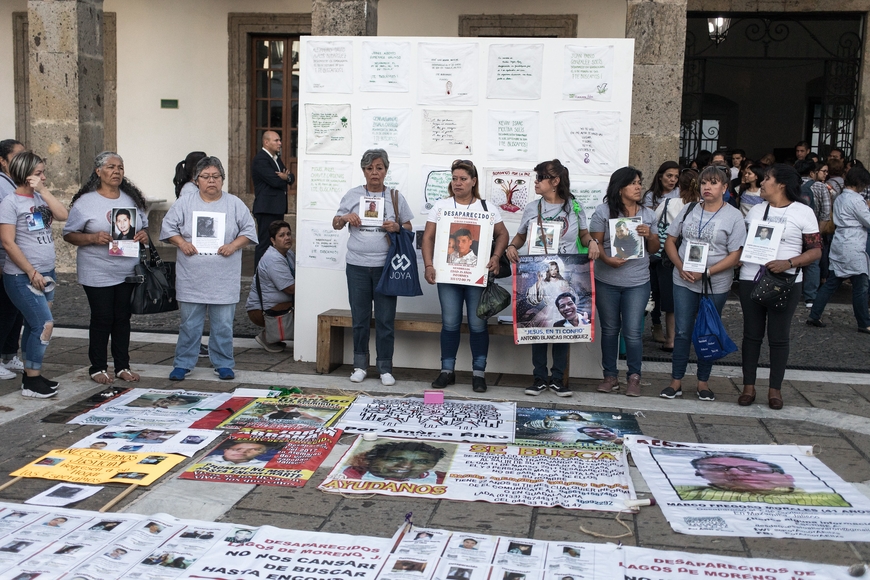Key Findings From Press Reports Of Disappearance Cases
In addition to the statistical analysis of the data (concerning the victims, perpetrators and the state’s response), two conceptual key findings emerged regarding the nature of the press reports on disappearances:
-
The study demonstrates the tendency of the press to report on each disappearance case as a single criminal event and not as an ongoing human rights violation. Given the continuous nature of disappearances, this event-focused reporting limits public understanding and discussion about the crimes. There are notable variations from this practice, including the use of investigative journalism to understand the phenomenon of disappearances, characterized by several collectives now operating in Mexico. However, the tendency to use “spot news” or “nota roja” in coverage of disappearance cases, as well as the enormous number of cases that received no coverage at all, limits the public’s access to information about the phenomenon that might lead to human rights change.
-
The study also shows that disappearance victims who were most newsworthy were persons from groups perceived as sympathetic—such as families, students, or persons who held prominent positions—police, public officials, businesspersons. Disappearance cases that were unusual, including group disappearances or those exhibiting extreme violence, also received more coverage. These findings extend the rarity theory of newsworthiness to situations of widespread human rights violations. The rarity theory asserts that victims who are ideal (females, children, and/or the elderly), stories that are unusual, or stories that involve more than one victim are considered newsworthy. The study also showed that families and civil society groups who advocate for disappeared persons increase the newsworthiness of their cases.
Spot News
Most Mexican news articles about disappearances provided their readers with limited information about the cases. Articles about disappearances usually included basic demographic information on the victim (e.g. gender, age), basic facts about the event (e.g. date, location, municipality) and, in about 41% of the reported cases, the articles suggested the suspected perpetrator. These reporting tendencies fit with a social-organizational newspaper model based on spot news or “notas del día”, described by McPherson (2012) in her analysis of Mexican press reporting. This model prioritizes news “as it happens” with a particular goal of attracting audiences accustomed to electronic media, including television. This spot news approach tends to rely on fewer sources and less investigation, resulting in fewer voices in the public sphere and less focus on accountability (McPherson 2012).
The spot news model can be seen in other aspects of the press articles in our database including the tendency to cover disappearance cases as singular events published in the crime section, and in a format named “nota roja”—or crime notes. This “nota roja” type of reporting fails to connect each disappearance to a wider pattern of human rights violations, and therefore removes the event from the more generalized context. This practice has also been critiqued in the literature with regard to news coverage about femicides in Mexico, which covered femicides as isolated events and not the result of structural violence against women. (De la Garza and Salazar 2020).
Reporter assignments for crime stories often circulate among a pool of staff reporters and, thus, a broad range of journalists may report on disappearance cases. At least 482 reporters are included in our database of news stories about disappearances, many of them assigned as part of a crime reporting pool in their media outlet. For security reasons, articles concerning organized crime may be labeled as “staff reporting” —with no specific individual byline. (Frey and Cuellar, 2020). We found this to be a common occurrence; 55% of disappearance cases in our database included at least one "staff reported" article.
Until several years into the disappearance crisis, few journalists had gained expertise on the phenomenon, such as how these crimes fit into the larger framework of human rights violations. Journalistic expertise in disappearance cases grew along with the crisis and, by the mid-2010s, several individual reporters and collective initiatives, such as A Donde Van los Desaparecidos, Quinto Elemento, Periodistas de a Pie and ZonaDocs, began to publish extraordinary and important investigations into the violence.
The focus of press reporting in these states was on the crime and not the search
for the disappeared person or the investigation of those responsible.
An additional tendency observed in this database was the lack of press follow up on disappearance cases. We saw little evidence of reporting on the state’s response or judicial proceedings in a disappearance case originally reported as a “nota roja”. Nor did the press typically conduct follow-up reporting to investigate the outcome of a disappearance such as whether the person was still missing or whether there had been an official search or investigation of the case. The focus of press reporting in these states was on the crime and not the search for the disappeared person or the investigation of those responsible. As such, the press outlets did not provide public information about “who should be held accountable, what they should be held accountable for, and how they should be held accountable” (Bonner 2009: 297).
Newsworthiness
We conducted an analysis of which cases were considered newsworthy in Mexican print media coverage of disappearances by using content analysis on the five reported disappearance events with the highest number of press articles in each of the four states in our database. We found that these highly reported cases tended to cover unusual crimes and/or ideal victims, confirming the rarity theory as an explanation of newsworthiness in the context of widespread violence, including disappearances at the hands of organized crime and state actors.
In addition to unusual or ideal victims, our newsworthy analysis points to coverage related to families or collectives who engage in visible campaigns on behalf of their disappeared loved ones. Our analysis of the top five cases and interviews with journalists suggest that advocacy by the families increases the newsworthiness of these disappearance cases.
Unusual Events: groups, seriousness or novelty
Past research using the rarity theory has found that rare or unusual events are considered more newsworthy and therefore receive more press coverage. Newsworthiness is determined by the unusualness of a crime, typified by the involvement of more than one victim or its degree of seriousness (Gekoski et al 2012); or its extraordinary or novel nature (Gruenewald et al 2013).
In terms of unusualness, our data establishes that group disappearances received higher media attention overall in Mexico, with an average of 7 articles per group disappearance and 4 articles per individual disappearance. Of course, the case of the 43 students in Ayotzinapa in 2014 represented the quintessentially unusual case in terms of its high number of victims, which increased its notoriety and generated long-term global coverage of the case.
Beyond this infamous case of mass disappearances, we found a general pattern showing that cases with a large number of victims drove media attention. For example, the case of twelve house painters who were disappeared together in Coahuila generated 16 articles (9 more than the average of 7 per group case); eleven police officers who were disappeared in Apodaca, Nuevo León generated 14 articles, (7 more than the group average), and seven young men who were disappeared in Lagos de Moreno in Jalisco generated 18 articles (11 more than the group average). The latter case was not technically a group disappearance, but was categorized by the media as such because of multiple disappearances of young men, 18-22 years of age, in the same territory and similar time frame. The cases became known as the “the Lagos de Moreno 7”.
Reporters we interviewed acknowledged that they and their editors paid more attention to group disappearances in their reporting than to crimes affecting a single victim. “It sounds distasteful,” one reporter told us, “but one disappeared person is not really newsworthy—it doesn’t have so much impact now because there are already so many disappeared. So, well yes, you were not going to be filling the newspaper with stories of disappeared persons, but it also depends on who was disappeared.” (Reporter interviewed by Olga Salazar Pozos, Monterrey, Nuevo León, June 9, 2019).
A final group of unusual cases were those that were extraordinary for their seriousness or novel outcomes. The case of the 11 police officers from Apodaca, Nuevo Leon, for instance, was notable not only for the number of victims but because eight officers, who sought to locate their three disappeared colleagues, themselves were disappeared. Cases which involved gruesome crimes were also covered, such as the brutal murder of a family in Guerrero, whose bodies were burned.
Ideal Victims: high-profile or sympathetic persons
Higher profile or sympathetic victims were the most newsworthy cases among the many disappearances in the four states we reviewed. Several high-profile disappearance victims were among the most covered cases, embodying the idea that “newsworthiness is greatly, possibly even primarily, concerned with measuring the ‘worth’ of the life lost” (Gekoski et al. 2012). In Nuevo León, for instance, the disappearance of Damián G, a businessman from San Pedro, an upper class and seemingly safe neighborhood, generated 16 articles (11 more than the average of 5 articles per individual case in the database), and the disappearance of Saul V, the mayor of Zaragoza, Coahuila, who was later found dead in Nuevo León, generated 20 articles (15 more than the average). In Guerrero, three different cases of social activists and politicians generated significant press attention. First, the case of Ranferi H, a former PRD politician and a social justice activist, who disappeared along with his family, generated 11 articles (6 more than the average). The disappearance of Silvia R, Ex-Secretary of Education and well-known PRD party member, received 13 articles (8 more than the average). Finally, the disappearance of Héctor, a 30-year-old human rights local activist and University of Guadalajara anthropology student, was covered in 11 articles (6 more than the average).
Other trends concerning sympathetic victims arose in our analysis of the most covered disappearance cases. Victims who are seen as blameless receive more media attention with a wider scope, and more thorough coverage (Gilchrist 2010; Gekoski et al. 2012 ). This explains the press’s interest in the disappearances of young people, especially children and students. For example, the case of a three-year-old in Coahuila, Johan G, that generated 16 articles (11 more than the average) and three university students from Zapopan, Jalisco that had 12 articles (7 more than the average), in addition to the widespread media attention to the three film students in Jalisco.
Another example of victims that are considered vulnerable by the literature on newsworthiness are female victims, since according to Chermark they are considered more “worthy” of news coverage than males (Gruenewald et al. 2013). Among the individual female victims in our analysis, we identified a highly covered case in Jalisco with 14 different press articles (9 more than the average of 5 articles) about a female high school student. Other cases of female victims who received high levels of news coverage in Guerrero, include Maria Luiz O, a feminist and human rights activist (6 more than the average). A mother and her baby left for dead in her car in Guerrero also generated sympathetic interest, with 15 press articles (8 more than the average).
Reporters we interviewed corroborated their tendency to cover sympathetic victims, especially based on the perceived reader’s response. One journalist from Nuevo Leon said, “So if you tell them that he was a 36-year-old man, you will see in the comments, ‘he was up to something’ or they will justify the disappearance in some way. And if you tell them that he was a student at the Autonomous University of Nuevo León or the Tec [de Monterrey] or the UDEM, everything changes, right?” (Reporter interviewed by Olga Salazar Pozos, Monterrey, Nuevo León, June 14, 2019.) Perceived reader response was therefore a material factor in reporter’s perceptions about the newsworthiness of disappearance victims.
Making cases visible: advocacy by families and civil society
The most highly reported cases in each state demonstrated that families who spoke out on behalf of their disappeared loved ones tended to increase the newsworthiness of the crime victim. Their actions led to more press coverage, humanized the public profile of the disappeared person, and in some cases resulted in more accountability by state officials.
Wives, mothers, fathers, and brothers who demanded action for justice on behalf of their disappeared loved ones received substantial coverage in our database. This held true whether the victim was a student (Daniela in Jalisco), a federal police officer (Juan H in Nuevo Leon), a public official (Esteban A in Coahuila), a human rights advocate (Hector in Guerrero), an engineer (Toño in Coahuila), or an amateur bull rider (Armando in Guerrero). In fact, in several cases, although the named victim was disappeared with a group, the advocacy by families increased the press coverage for their disappeared loved one over the others. This was true, for instance, in the disappearance of Juan H, whose case was covered in twice as many articles (12 v. 6) as another federal police officer, Juan Luis L, who disappeared in the same incident in the midst of a police quarter in Nuevo Leon. The outspoken advocacy of Juan H’s mother led to more coverage.
Civil society organizations also played a role in making cases more visible in the press. Journalists we interviewed repeatedly noted the importance of human rights organizations and families’ collectives as their sources in reporting on disappearance cases. Daniel de la Fuente, a journalist with the Reforma Group, explained his work on a special series published simultaneously in three major news outlets (Mural, Reforma and El Norte) to tell in-depth stories about victims of disappearances. De la Fuente noted, “we relied heavily on CADHAC, and we are very grateful to [Sr.] Consuelo [Director of CADHAC] for all that she has done in these years. That series was very important, it shocked, outraged, made [the cases] visible. None of the cases were resolved, none of those people returned, few officials were detained.” (Reporter interviewed by Olga Salazar Pozos, Monterrey, Nuevo León, July 9, 2019).
Our analysis of the top five cases in each state also showed that families played active roles in pushing back against any governmental or press narratives that criminalized the victims. In the case of Daniela of Jalisco, for instance, the family publicly rejected the state’s attorney’s blame-shifting to the young student. Their public advocacy resulted in more press coverage of her disappearance, and it also humanized Daniela in the public’s eyes. In response, state officials held press conferences and updates on the investigation of Daniela’s case, unusual occurrences in reported cases of enforced disappearances.




